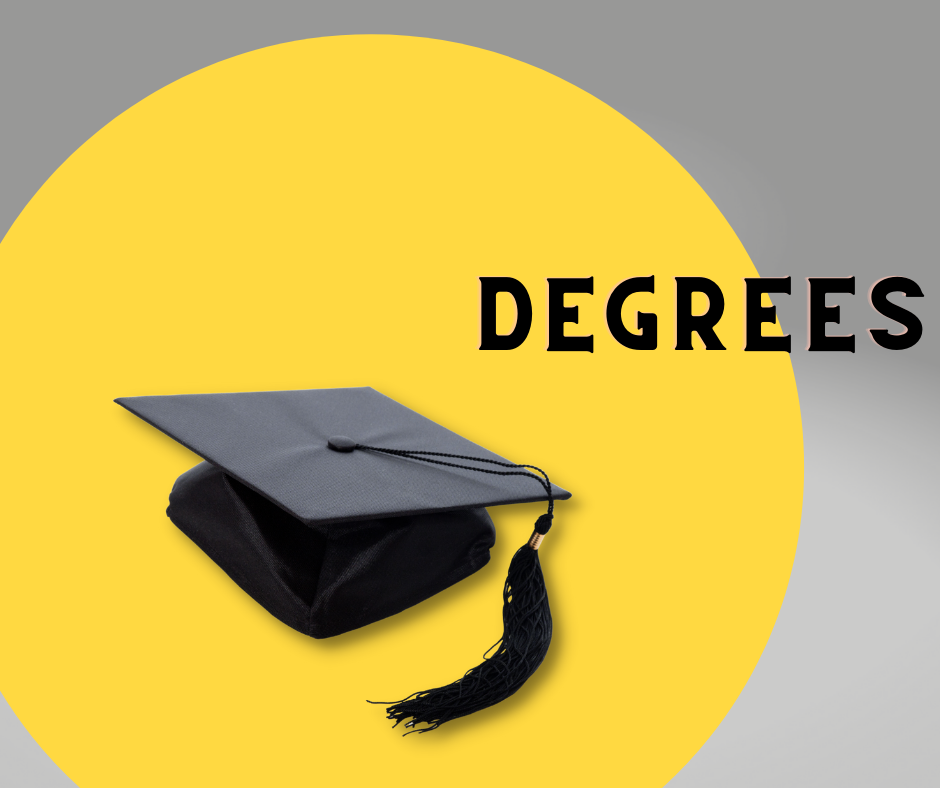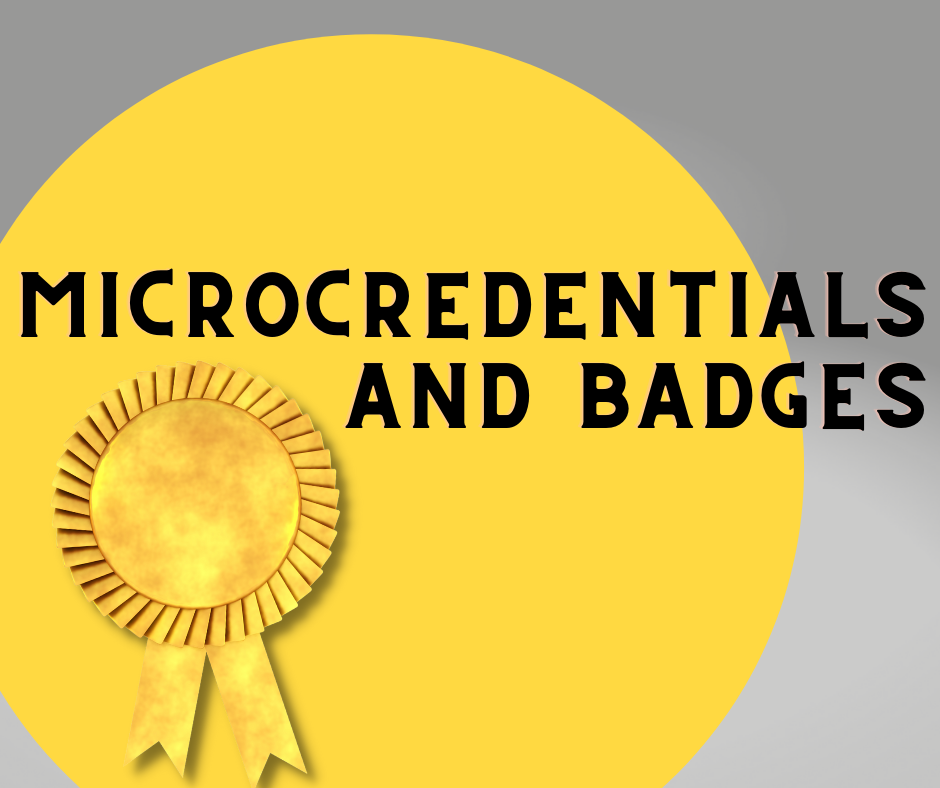
Families may find definitions and general information are helpful in understanding how postsecondary education program function. The following segment will present useful terms that may help you as you progress through the Family2Family Toolkit, and ultimately support your students in their postsecondary education pursuits.
Degrees, Majors, Certificates, Credentials, Certifications, College Experiences: How to Navigate the Best Pathway for Your Student!
Isn’t it a wonderful feeling when you finish a big
project, a task, or a goal that seemed impossible? Having
proof of your accomplishment makes your energy and time
commitment even more meaningful. Students with
disabilities who complete postsecondary education degrees
or programs also benefit from having evidence or proof of
their accomplishments, which in turn, can lead to
employment, community engagement, and satisfaction with
their lives (Dutta et al., 2019; Huber et al., 2016).
When we think of evidence that a person has achieved
specific levels of knowledge, skills, or abilities, we
sometimes use the word, credentials.
Credential is used as “an umbrella term that includes
degrees, diplomas, licenses, certificates, badges,
and professional/industry certifications,” (New England
Board of Higher Education, 2020). For purposes of this
Toolkit used by students and their families as they think
about postsecondary education programs, we will use
credentials in two ways:
- The first use of the word credentials is general (for example, degrees, certificates, licenses), and it is any written proof that the student has completed the necessary education and training for employment positions while enrolled in a postsecondary education program.
- The second use of the word credentials is more specific (see later in the following definitions). In this case, credential is used to mean written proof of the completion of necessary education and training in a specific area of study (for example, childcare or culinary arts).
Identifying and defining the varieties of evidence or proof available in postsecondary education helps students and their families make decisions that match what the student wants to accomplish. The following section provides students and families with definitions of common terms used when students complete degrees, programs or experiences.

Degrees are earned by students at a college or university. Students who earn degrees have been accepted into a college or university and have passed required classes and internships/experiences in an area of study. Undergraduate students earn associate’s degrees or bachelor’s degrees, and several students with ID have earned degrees in colleges and universities across the country.
Associate's Degrees are available to students after high school and offer students basic technical or academic knowledge and skills that pave the way to further education (bachelor’s degree in a college or university) or employment. Associate’s Degrees include passing around 60 credit hours in an area of study and are usually an associate of arts or an associate of science. Some students complete an Associate’s Degree in two years, and others take longer because of work responsibilities or a need to take fewer classes in a semester.
Examples of Associate's Degrees: Associate of Applied Arts, Associate of General Studies, Associate of Criminal Justice, Associate of Medical Assisting
Types of Educational Institutions to Earn Associate’s Degrees: Public colleges and universities, private colleges and universities, state colleges, community colleges, junior colleges, technical schools or institutes. Check each institution to find out if they offer Associate’s Degrees.
Bachelor’s Degrees also are available to students after high school; however, usually students must be eligible for admittance (for example, acceptable high school grades and college entrance exams such as SAT or ACT scores with an acceptable score) and acceptance to a college or university. Acceptance to a degree program may be competitive so investigate requirements before you apply. Some students first earn an Associate’s Degree that may gain them admittance to a college or university that offers Bachelor’s Degrees.
Students earn a Bachelor’s Degree by completing and passing around 120 hours of required classes in a chosen field of study. Bachelor’s Degrees may be a Bachelor of Arts or Bachelor of Science.
Examples of Bachelor’s Degrees: Bachelor of Arts in Marketing, Bachelor of Science in Biology, Bachelor of Arts in Sociology
Types of Educational Institutions to Earn Bachelor’s Degrees: Public colleges and universities, private colleges and universities, state colleges, some community colleges, some technical schools or institutes. Check each institution to find out if they offer Bachelor’s Degrees.
Acceptance and admittance procedures vary from college to college. Check the requirements for acceptance at each university if your student plans to apply for either the Associate’s or Bachelor’s degrees.

A Major is a program of study or set of classes students take to earn a degree. Majors are chosen by students in specializations or fields they select based on their interests, abilities, or preferences. Some students declare a major when they enroll in a college or university program, while others may wait as many as two years before deciding on a major. Advisors or career counselors on campus are helpful to students as they decide majors.
Some majors may have limited access. What this means is students must have a specific grade point average (GPA), specific scores on degree entrance exams (for example, ACT or SAT), pass an audition, pass an interview process, or other degree entrance requirements. Websites and advisors can provide information on limited access majors and degree programs.
Examples of Majors: Music Performance, Sport Management, Nursing, Accounting, Computer Science, Communication
Types of Educational Institutions to Offer Majors: Public colleges and universities, private colleges and universities, state colleges, community colleges, technical colleges or institutes. Check each institution to find out if they offer specific major areas of study.

Credentials are proof, usually in written form, that students have completed programs or training that helps qualify them for a specific type of employment. When postsecondary education programs describe credentials, they are providing written proof that the student has completed the necessary education and training for particular employment positions.
For example, if a postsecondary education program offered in a credential in early childhood care, students who complete the early childhood care credential may qualify to apply for work as a childcare assistant or educational assistant in a preschool. A part of good credentialing programs is that program personnel may assist their students in identifying possible employment positions for which they qualify after earning their credentials.
Examples of Credentials in Postsecondary Education Programs: Credential in Hospitality, Credential in Childcare Assistant, Credential in Marine Biology Assistant
Types of Educational Institutions to Offer Credentials: Public colleges and universities, private colleges and universities, state colleges, community colleges, technical colleges or institutes. Check each institution to find out if they offer Credentials in the postsecondary education program or at the institution.

Microcredentials tend to be more specialized or focused than a degree program or credentialing program, and they demonstrate that the student has mastered one or more job competencies (Maxwell & Gallagher, 2020). Microcredentials are individualized to the student and target specific skills or learning outcomes. The information about what the student has learned is sometimes housed in an electronic visual tool called a badge, a tool that is explained in the following paragraph.
Badges, including digital badges are credentialing devices that are typically managed online. They show potential employers what the student has learned and mastered, both in classroom and work environment settings. The online data shows who awarded the badge, what competencies the student mastered to earn the badge, when the badge was earned, and if the microcredential expires (Hunt et al., 2019).
Examples of Microcredentials and Badges in Postsecondary Education Programs: Safe food preparation, basic behavior management in children, or safe disposal of materials in air conditioning repair. Badges are used to provide electronic proof of the microcredentials earned by the student.
Types of Educational Institutions to Offer Credentials: Some public colleges and universities, some private colleges and universities, state colleges, community colleges, technical schools colleges or institutes. Check each institution to find out if they offer microcredentials and/or badges in the Postsecondary Education program or at the Institution.

Certificates are earned by students after they successfully complete a brief course of study that may range from a short duration of time to a year or more. Certificates may be awarded for completing a course or attaining certain skills or competencies in a field. They may be given to recognize either foundational skills or knowledge up to advanced learning (Maxwell & Gallagher, 2020). For example, a student may earn a cosmetology certificate in the skill of washing hair. Having an industry-recognized skill will help that student find appropriate employment by employers who know what the student’s skills and competencies are because he or she has earned a certificate. The student may choose to pursue additional certificates that lead to credentials and/or licensed professions.
Examples of Certificates in Postsecondary Education Programs: Auto Mechanics, Culinary Arts, Cosmetology, Engine Repair, Air Conditioning.
Types of Educational Institutions to Offer Certificates: some public colleges and universities, some private colleges and universities, state colleges, community colleges, technical schools or institutes. Check each institution to find out if they offer certificates in the postsecondary education program or at the Institution.

Certifications are proof or evidence that a student earned a level of competence, skills or knowledge, usually based on passing an examination developed by professionals in the student’s chosen field. Certifications are usually earned through an assessment that can be written, spoken, and based on student’s work performances. The certification proves that the student has the industry-recognized knowledge, skills, and abilities to work at a specific job (Maxwell & Gallagher, 2020).
Examples of Certifications in Postsecondary Education Programs: Licensed Practical Nurse, Medical Assistant, Dental Assistant, Emergency Medical Technician, Teacher, Paraprofessional, Web Developer, Optician, Funeral Director, Firefighter
Types of Educational Institutions to Offer Certification: some public colleges and universities, some private colleges and universities, state colleges, community colleges, technical colleges or institutes. Check each institution to find out if they offer certification in the postsecondary education program or at the Institution.
Getting Connected in College
When we consider how students are connected during their educational journey, we focus on the time students with disabilities learn, interactm hang out or socialize with their peers without disabilitiess. The same is true for postsecondary education at colleges, universities or technical schools. Families and students should investuage the opportunities for students to be connected on the campus to help them decide if the options available match their family expectations. Ask postsecondary education staff and campus staff questions such as the ones listed here.
Program Support Structure
Think of words that may define the word, support. They could include reinforcement, base, foundation, scaffold, and promotion. Structure can be explained by words such as make up, shape, configuration, organization or arrangement. As we consider postsecondary education programs, families and students need to be aware of the foundational organization or how a program is designed to work for students in all parts of the program. This is the basic information or support, with the structure showing how this support is organized throughout the program. In short, support structures are the program components that offer students the assistance they need.
The Type of Support Structures will help to identify the best matches for types of support structures your student needs. You can pose these questions to postsecondary education program staff or appropriate campus personnel. Some of the answers to these questions may be found by visiting websites, reading written material about the programs or attending Open Houses about programs.
College Experience programs offer a postsecondary experience for students with ID to experience college with their same-age peers. These programs may provide peer mentors or program clubs for students to build their social and interpersonal skills. College experience programs often offer access to facilities (for example, gyms, libraries) and opportunities (for example, clubs, concerts and events) on campus. Some college experience programs offer students the opportunity to take classes with their peers, either by auditing the classes or taking classes for credit. Other college experience programs offer their own classes within the program for students. Internships and paid employment may be a part of college experience programs.
Examples of Exit Papers in College Experience Programs: Some programs give students Certificates that indicate they have completed the College Experience Program. Others have developed diplomas that indicate the accomplishment of the program. Check with each program to discover what exit documents they provide when the student completes the program.
Types of Educational Institutions to Offer College Experience Programs: some public colleges and universities, some private colleges and universities, state colleges, community colleges, technical colleges or institutes. Check each institution to find out if they offer certification in the postsecondary education program or at the Institution.
If you would like to learn more about exit materials, Think College has compiled the following materials on the topic. Click on the FIZZ logo.
A mission statement typically summarizes the intentions and values of an organization. Many universities, colleges, and technical schools have mission statements that offer students, families and community members ideas about what the school believes, how the school supports students, and the values the school promotes. For example, the FCSUA is located on the campus of the University of Central Florida (UCF). The mission statement of UCF reads as follows:
The University of Central Florida is a public multi-campus, metropolitan research university that stands for opportunity. The university anchors the Central Florida city-state in meeting its economic, cultural, intellectual, environmental and societal needs by providing high-quality, broad-based education and experienced-based learning; pioneering scholarship and impactful research; enriched student development and leadership growth; and highly relevant continuing education and public service initiatives that address pressing local, state, national, and international issues in support of the global community.
Postsecondary education programs located on campuses likely have mission statements that align or follow the mission statement of the campus. These statements are usually found on the programs’ websites and other information disseminated by the program.
